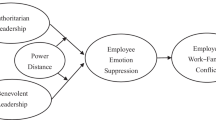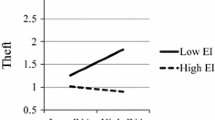Abstract
Nine hypotheses were developed from the emerging literature on negative emotion in the workplace. In order to test these hypotheses, the responses of 167 employed master's students to measures of individual differences (self-esteem and Machiavellianism), work unit attributes (autonomy, competitive reward, and supervisory considerateness) and personal response variables (sense of control, organization-based self-esteem, and propensity to quit) were analyzed with bivariate and hierarchical regression analyses. Results of these analyses were generally supportive of the predicted relationships. Findings are interpreted as indicating the utility of the constructs of employee jealousy and envy for understanding individual experiences of interpersonal stress.
Similar content being viewed by others
REFERENCES
Adler, N., & Matthews, K. (1994). Health psychology: Why do some people get sick and some stay well? Annual Review of Psychology, 45, 229-259.
Ambrose, M. L., Harland, L. K., & Kulik, C. T. (1991). Influence of social comparisons on perceptions of organizational fairness, Journal of Applied Psychology, 76, 239-246.
Baron, R. A., & Neuman, J. H. (1996). Workplace violence and workplace aggression: Evidence on their relative frequency and potential causes. Aggressive Behavior, 22, 161-173.
Bass, B. M. (1990). Bass and Stogdill's handbook of leadership, 3rd ed. New York: Free Press.
Bentler, P. M. (1990). Comparative fit indices in structural models, Psychological Bulletin, 107, 238-246.
Bentler, P. M., & Chou, C. (1987). Practical issues in structural modeling. Sociological Methods and Research, 16, 78-117.
Blascovich, J., & Tomaka, J. (1991). Measures of self-esteem. In J. P. Robinson & L. S. Wrightsman (Eds.), Measures of personality and social psychological attitudes. (pp. 115-160). San Diego: Academic Press.
Bollen, K. (1989). Structural equations with latent variables. New York: Wiley.
Brooke, P. P., Russell, D. W., & Price, J. L. (1988). Discriminant validation of measures of job satisfaction, job involvement, and organizational commitment, Journal of Applied Psychology, 73, 139-145.
Cattell, R. B. (1966). The scree test for the number of factors. Multivariate Behavioral Research, 1, 245-276.
Centers for Disease Control and Prevention. (1993). Preventing homicide in the workplace. U.S. Department of Health and Human Services. September, Publication No. 93-109.
Christie, R., & Geis, F. (1976). Studies in Machiavellianism. New York: Academic Press.
Cohen, J., & Cohen, P. (1983). Applied multiple regression/correlation analysis for the behavioral sciences. Hillsdale, NJ: Erlbaum.
Cooper, C. L., & Cartwright, S. (1997). An intervention strategy for workplace stress. Journal of Psychosomatic Research, 43, 7-16.
Coyne, J. C., & Downey, G. (1991). Social factors and psychopathology: Stress, social support, and coping processes. Annual Review of Psychology, 42, 401-425.
Crandall, R., & Perrewé, P. L. (1995). Occupational stress: A handbook. Washington, DC: Taylor and Francis.
Delgado, A. R., & Bond, R. A. (1993). Attenuating the attribution of responsibility: The lay perception of jealousy as a motive for wife battery. Journal of Applied Social Psychology, 23, 1337-1356.
Diener, E., & Emmons, R. A. (1985). The independence of positive and negative affect. Journal of Personality and Social Psychology, 47, 1105-1117.
Dillman, D. A. (1978). Mail and telephone surveys: The total design method. New York: J. Wiley & Sons.
Edwards, J. R. (1992). A cybernetic theory of stress, coping, and well-being in organizations. Academy of Management Review, 17, 238-274.
Elliott, R. H., & Jarrett, D. T. (1994). Violence in the workplace: The role of human resources management, Public Personnel Management, 23, 287-299.
Ferris, G. R., Judge, T. A., Rowland, K. M., & Fitzgibbons, D. E. (1994). Subordinate influence and the performance evaluation process: Test of a model. Organizational Behavior and Human Decision Processes, 57, 1-35.
Vecchio Fowler, F. J. (1993). Survey research methods, 2nd ed. Newbury Park, CA: Sage Publications.
Harris, C. R., & Christenfeld, N. (1996). Gender, jealousy, and reason. Psychological Science, 7, 364-366.
Havlovic, S. J., & Keenan, J. P. (1995). Coping with work stress: The influence of individual differences. In R. Crandall & P. L. Perrewe´ (Eds.), Occupational stress: A handbook. (pp. 179-192). Washington, DC: Taylor and Francis.
Hinkin, T. R. (1998). A brief tutorial in the development of measures for use in survey questionnaires. Organizational Research Methods, 1, 104-121.
Hochschild, A. R. (1979). Emotion work: Feeling rules and social structure. American Journal of Sociology, 85, 551-575.
Hupka, R. B., & Bachelor, B. (1979). Validation of a scale to measure romantic jealousy. Paper presented at the Annual Meeting of the Western Psychological Association, San Diego, CA.
Ivancevich, J. M., Matteson, M. T., Freedman, S. M., & Phillips, J. S. (1990). Work stress management interventions. American Psychologist, 45, 252-261.
Jöreskog, K. G. & Sörbom, D. (1993). LISREL 8: Structural equation modeling with the SIMPLIS command language. Chicago, IL: Scientific Software International.
Kahn, R. L., & Byosiere, P. (1992). Stress in organizations. In M. Dunnette & L. Hough (Eds.), Handbook of industrial and organizational psychology (pp. 571-650). Palo Alto, CA: Consulting Psychologists Press.
Kinicki, A. J., McKee, F. M., & Wade, K. J. (1996). Annual review, 1991-1995-Occupational health. Journal of Vocational Behavior, 49, 190-220.
Latack, J. C., & Havlovic, S. J. (1992). Coping with job stress: A conceptual evaluation framework for coping measures. Journal of Organizational Behavior, 13, 479-508.
Lazarus, R. S. (1994). Psychological stress in the workplace. In R. Crandall & P. L. Perrewé (Eds.), Occupational stress: A handbook (pp. 3-14). Washington, DC: Taylor & Francis.
Lazarus, R. S., & Folkman, S. (1984). Stress, appraisal, and coping. New York: Springer.
Lindquist, T. L., & Cooper, C. L. (1999). Using lifestyle and coping to reduce job stress and improve health in 'at risk' office workers. Stress Medicine, 15, 143-152.
Locke, E. A., & Taylor, M. S. (1990). Stress and the meaning of work. In A. Brief & W. Nord (Eds.), Meanings of occupational work (pp. 135-170). Lexington MA: Lexington Books.
Locke, E. A., McClear, K, & Knight, D. (1996). Self-esteem and work. International Review of Industrial and Organizational Psychology, 11, 1-32.
Lusk, S. L. (1992). Violence in the workplace. Journal of the American Association of Occupational Health Nurses, 40, 212-223.
Mathes, E. W. (1992). Jealousy: The psychological data. New York: University Press of America.
Matteson, M. T., & Ivancevich, J. M. (1987). Controlling work stress. San Francisco: Jossey-Bass.
Mumford, M. D. (1983). Social comparison theory and the evaluation of peer evaluations: A review and some applied implications, Personnel Psychology, 36, 867-881.
Myers, D. G., & Diener, E. (1995). Who is happy? Psychological Science, 6, 10-19.
National Victim Center (1994). Workplace violence, Vol. 1, No. 67. Fort Worth, TX.
Neuman, J. H., & Baron, R. A. (1998). Workplace violence and workplace aggression: Evidence concerning specific forms, potential causes, and preferred targets. Journal of Management, 24, 391-419.
Nunnally, J. (1978). Psychometric theory. New York: McGraw Hill.
O'Boyle, T. F. (1992). Disgruntled workers intent on revenge increasingly harm colleagues and bosses. Wall Street Journal, September 15, B1 and B10.
Organ, D. W., & Konovsky, M. (1989). Cognitive versus affective determinants of organizational citizenship behavior. Journal of Applied Psychology, 74, 157-164.
Parrott, W. G. (1991). The emotional experiences of envy and jealousy. In P. Salovey (Ed.), The psychology of jealousy and envy (pp. 3-30). New York: Guilford Press.
Parrott, W. G., & Smith, R. H. (1993). Distinguishing the experiences of envy and jealousy. Journal of Personality and Social Psychology, 64, 906-920.
Pearlin, L., Lieberman, M., Menaghan, E., & Mullan, J. (1981). The stress process. Journal of Health and Social Behavior, 22, 337-356.
Pedhauzer, E. J. (1982). Multiple regression in behavioral research: Explanation and prediction. New York: CBS College Publishing.
Pierce, J. L., Gardner, D. A., Cummings, L. L., & Dunham, R. B. (1989). Organization-based selfesteem: Construct definition measurement and validation, Academy of Management Journal, 32, 622-648.
Rafaeli, A., & Sutton, R. J. (1989). The expression of emotion in organizational life. In L. Cummings & B. M. Staw (Eds.), Research in Organizational Behavior, 11 (1-42). Greenwich, CT: JAI Press.
Rafaeli, A., & Sutton, R. J. (1991). Emotional contrast strategies as means of social influence: Lessons from bill collectors and interrogators. Academy of Management Journal, 34, 749-775.
Regdon, J. E. (1994). Companies see more workplace violence. Wall Street Journal, April 12, B1 and B6.
Robinson, S. L., & Bennett, R. J. (1995). A typology of deviant workplace behaviors: A multidimensional scaling study. Academy of Management Journal, 38, 555-572.
Rosenberg, M. (1965). Society and the adolescent self-image. Princeton, NJ: Princeton University Press.
Rosenberg, M. (1979). Conceiving the self. New York: Basic Books.
Russell, J. A. (1991). Culture and the categorization of emotions. Psychological Bulletin, 110, 426-450.
Salovey, P. (1991). The psychology of jealousy and envy. New York: Guilford Press.
Selye, H. (1976). The stress of life. New York: McGraw-Hill.
Sheppard, B. H., Lewicki, R. J., & Minton, J. W. (1992). Organizational justice: The search for fairness in the workplace. New York: Lexington Books.
Smith, R. H., Kim, S. H., & Parrott, W. F. (1988). Envy and jealousy: Semantic problems and experimental distractions. Personality and Social Psychology Bulletin, 14, 401-409.
Staw, B. M., Sutton, R. I., & Pelled, L. H. (1994). Employee positive emotion and favorable outcomes at the workplace, Organization Science, 5, 51-71.
Stearns, P. N. (1989). Jealousy: The evolution of an emotion in American history. New York: New York University Press.
Stogdill, R., & Coons, A. (eds.) (1957). Leader behavior: Its description and measurement (Research Monograph No. 88). Columbus: Ohio State University, Bureau of Business Research.
Stuart, P. (1992). Murder on the job, Personnel Journal, 71, 72-84.
Tetlock. P. E., & Manstead, A. S. R. (1985). Impression management versus intrapsychic exploration in social psychology: A useful dichotomy, Psychological Review, 92, 59-77.
Van Maanen, J., & Kunda, G. (1989). Real feelings: Emotional expression and organizational culture. In B. Staw & L. Cummings (Eds.), Research in Organizational Behavior, 11 (pp. 43-103). Greenwich, CT: JAI Press.
Vecchio, R. P. (1995). It's not easy being green: Jealousy and envy in the workplace. In G. R. Ferris (Ed.), Research in Personnel and Human Resources Management, 13 (pp. 201-244). Greenwich, CT: JAI Press.
Vecchio, R. P. (1999). Jealousy and envy among health care professionals. In P. M. LeBlance, M. Peters, A. Büssing, W. Schaufeli (eds.), Organizational Psychology and Health Care (pp. 121-132). Munich: Rainer-Hampp-Verlag.
White, G. L., & Mullen, P. E. (1989). Jealousy: Theory, research, and clinical strategies. New York: Guilford Press.
Williams, L. J., & Hazer, J. T. (1986). Antecedents and consequences of satisfaction and commitment in turnover models: A reanalysis using latent variable structural equation methods, Journal of Applied Psychology, 71, 219-231.
Rights and permissions
About this article
Cite this article
Vecchio, R.P. Negative Emotion in the Workplace: Employee Jealousy and Envy. International Journal of Stress Management 7, 161–179 (2000). https://doi.org/10.1023/A:1009592430712
Issue Date:
DOI: https://doi.org/10.1023/A:1009592430712




